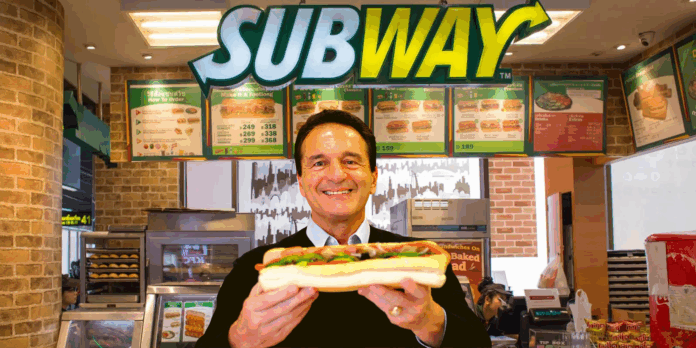Subway currently holds the status of being the biggest fast-food chain on the planet. They surpassed McDonald’s and KFC’s store count decades ago with over 44,000 stores in 110 countries. Last year they generated $1.3 billion in revenue (triple since 2019).
Their recent spike in gross sales though has exposed a tragic dilemma facing the franchise. More on that in a second but first, here’s how it all started.
Subway was launched by a 17-year-old from the Bronx who had never made a sub in his life until opening day. Despite his lack of subs, the sandwiches he sold eventually earned him a net worth of approximately $3 billion and became the most successful franchise business on the planet.
The Founder of Subway Never Wanted to be in Business…
Subway launched in 1965 when 17-year-old Fred DeLuca asked his family friend, Dr. Peter Buck, a nuclear physicist, for advice on how to pay his college tuition. With an idea to open a submarine sandwich shop and an initial $1,000 investment from Dr. Buck, the two formed a business partnership.
In fact, Fred had zero intentions of ever becoming a businessman. This was his plan to put himself through school in order to become a doctor.
The partners opened their first restaurant in Bridgeport, Connecticut, in August of 1965, where they served freshly-made, customizable and affordable sandwiches to local guests. Subway was originally called ‘Pete’s Super Submarines’.
And people ate up the concept of a giant foot-long sandwich “made right before your eyes, the way you want ’em.” As it turns out, customizing your sandwich was a novelty in the fast food industry. This is probably also where Burger King adopted their slogan; “have it your way”.
Subway’s Insanely Effective Franchise Model…
What put Subway on the entrepreneurial map was their decision to begin franchising with a goal of operating a chain of 35 stores. The franchise model launched the Subway brand into a period of incredible growth and popularity.
Not only were Subway franchises successful, they were, and still are, one of the cheapest chains to open in the franchise world. It costs between $116,000 and $263,000 to open a Subway franchise. Compare that to opening a McDonald’s, which costs up to $2.2 million.
But here’s the catch…
Because Subways are easy to open, the number of stores skyrocketed. Between 1990 and 1998, store locations rose steeply from 5,000 to 13,200. And in that same period of time, gross sales rose by about $2.1 billion. Subway’s success continued into the early 2000s. At a time when obesity was rising rapidly in America, Subway continued to market itself as a healthy alternative to fast food.
Things were going great, until this happened…
Is This the Beginning of the End for Subway?
Starting in 2014, Subway’s sales began steadily dropping. Behind the scenes, many of the reasons for Subway’s success had turned on them. Quiznos was once Subway’s main competition, but tons of sub chains, like Jimmy John’s, Firehouse, Potbelly, and Jersey Mike’s, and fast-casual chains like Panera, were offering similar fresh and healthier options for sandwiches and wraps. Stealing away Subway’s dominant market share.
Other fast-food chains weren’t the only competition for Subway franchises. With Subway’s franchising model making it so easy to open locations, stores inevitably started opening up around the corner from each other in lucrative markets. And these locations in close proximity began cannibalizing each other’s sales.
It’s a real problem…
Subway’s Franchise Model Has Been Under Attack Since the 90s
In recent years, Subway has closed thousands of locations. Here’s why…
The Subway franchise agreement states the company can open locations anywhere they want. There’s no protected territories for the owners. So franchisees really have no say-so in where the other franchisees are going to open.
In 2016, Subway’s US location count dropped by 359. It lost another 909 locations in 2017. It dropped another 1,108 locations in 2018. In part due to market saturation and a drop in sales, but also Subway has been attempting to clean up the cannibalization problem that plagues their franchisees.
Another contributing factor to Subway’s dip in growth for their store locations are the size of the companies royalties at nearly 10% of sales!
The company’s 8% royalties (which are still in effect today) are the highest in the industry (compared to 3-5% at other fast food stores like McDonald’s)
But all criticism aside, the brand still maintains 60% of the quick-service sandwich market in the U.S. A pretty impressive accomplishment for a kid from the Bronx with zero experience.
WATCH:
For more information visit tylerhayzlett.com





